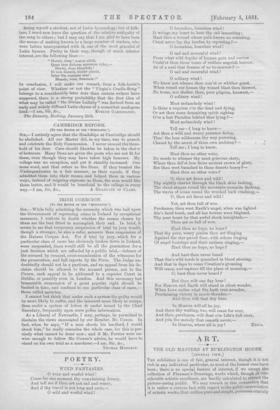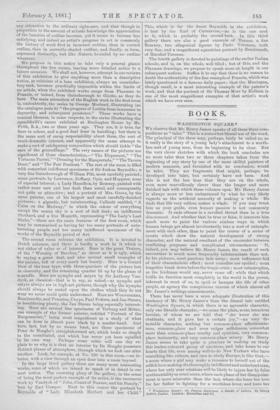ART.
THE OLD MASTERS AT BURLINGTON HOUSE. [GENERAL VIEW.] THE exhibition is one of fair, general interest, though it is not rich in any individual particular, as most of the former ones have been; there is no special feature of interest, if we except the collection of Flaxman's Drawings, works which, though of con- siderable artistic excellence, are hardly calculated to attract the picture-seeing public. We may remark in this connection that it is rather a curious fact with regard to the public appreciation of artistic works, that outline pure and simple, possesses scarcely -any attraction to the ordinary sight-seer, and that though iu proportion to the amount of artistic knowledge the appreciation of the beauties of outline increase, yet it seems to become less satisfying, and indeed an artist's progress in art is commonly the history of work first in incorrect outline, thou in correct outline, then in correctly-shaded outline, and finally, iu form, expressed distinctly, but like Nature, bounded by no outline whatever.
We propose in this notice to take only a general glance throughout the five rooms, leaving more detailed notice to a future occasion. We shall not, however, attempt in our reviews -of this exhibition to give anything more than a descriptive notice, as criticism of a loan exhibition, always an unsatisfac- tory task, becomes practically impossible within the limits of an article, when the exhibited works range from Flaxman to Francia, or indeed, from Gainsborough to Giotto, as they do here. The main attraction of the English Work in the first room is, undoubtedly, the series by George Morland, illustrating (as the catalogue puts it) "the progress of Letitia from innocence to -depravity, and subsequent penitence." These works have a comical likeness, in some respects, to the series illustrating the spendthrift's career exhibited at Burlington House by Mr.
Frith, R.A., two or three years ago. They are, it is true, far finer in colour, and a good deal freer in handling; but there is the same sort of smug respectability about them, the sort of -mock-dramatic interest, and apparently the same attempt to make a sort of catchpenny composition which should tickle " the ears of the groundlings." The very names of the pictures are significant of these characteristics,—" The Elopement," " The Virtuous Parent," "Dressing for the Masquerade," " The Tavern Door," and " The Fair Penitent." The rest of the room is filled with somewhat indifferent specimens of Sir Joshua Reynolds ; a very fine Gainsborough of William Pitt, most carefully painted ; some portraits by Lawrence, Zoffany, Opie, and Hoppner, none of especial interest ; a Lady Hamilton,by Romney, painted with rather more care and less dash than usual, and consequently not quite so attractive ; and a portrait of Mrs. Grove, by the same painter, one of his largest and most carefully-finished ;pictures; a gigantic, but uninteresting, Callcott entitled, "A 'Calm on the Medway," in which the colour of everything except the sunny sky is a sort of dull drab; an indifferent Stothard, and a fine Hogarth, representing " The Lady's Last Stake,"—these are the main features of the first room, which may be summarised as having far too many portraits of unin- teresting people, and too many indifferent specimens of the -works of the Reynolds period of Art.
The second room redeems the exhibition. It is devoted to Dutch painters, and there is hardly a work in it which is not either of value or of interest. Here is the great Teniers, of the " Worship of Bacchus," as clever as it is ugly, which dis saying a great deal, and also several small examples of the painter, full of every merit but beauty. Here is a Gerard Dow of the true type, with three-quarters of the picture lost in obscurity, and the remaining quarter lit up by the gleam of aeandle. Here are nymphs and satyrs by Sir Anthony Van- xlyck, as classical—that is to say, as naked—as nymphs and satyrs always are in high-art pictures, though why the nymphs should always be seated upon the clothes which they do not wear we never could quite understand. Here are Wouvermans, Rembrandts, and Poussius, Cuyps, Paul Potters, and Jan Steens, in bewildering plenty, the Jan Steens being especially interest. ing. Here are several fine specimens of Terburg and Metzu, one example of the former painter, entitled " Portrait of the Burgomaster," being most magnificent as a study of what can be done in almost pure black by a master-hand. And here, last, but by no means least, are three specimens of Peter de Hooghe's straightforward art, which looks so simple to the uninitiated, and which has never yet been equalled In its own way. Perhaps some critic will one day ex- plain to us why it is that an interior by De Hooghe possesses distinct planes of atmosphere, through which we look one after another. Look, for example, at No. 120 in this room,—an in- terior, with a view through an open door into a room beyond. In the large third gallery there are many most interesting -works, some of which we intend to speak of in detail in our next notice. The crowning glory of the gallery, in the sense of being the most perfect example of its artist, is the enormous work by Vandyck of " John, Count of Nassau, and his Family," 'lent by Earl Cowper. Next to this comes the portrait by Reynolds of " Lady Elizabeth Herbert and her Child." This, which is far the finest Reynolds in the exhibition, is lent by the Earl of Carnarvon,—as is the one next to it, which is probably the second-best. In this third gallery there are also a good example of Turner, a fine Romney, two allegorical figures by Paolo Veronese, both very fine, and a magnificent equestrian portrait by Rembrandt, of Marshal Turenne.
The fourth gallery is devoted to paintings of the earlier Italian schools, and is, on the whole, well filled ; but of this, and the Flaxman drawings, we propose to speak more at length in our subsequent notices. Suffice it to say that there is no reason to doubt the authenticity of the fine example of Francia, which was lately questioned in a famous daily paper ; that the Mantegna, though small, is a most interesting example of the painter's work, and that the portrait of Sir Thomas More by Holbein is one of the most magnificent examples of that artist's work which we have ever seen.



































 Previous page
Previous page